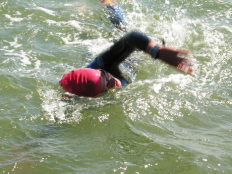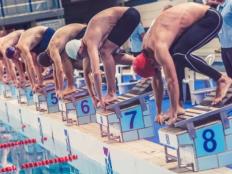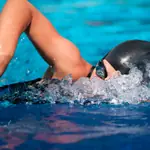WORKOUT:
Round 1:
- Swim: Four descending 200s with 30 seconds rest between each.
- Pace the 200s so that you descend each by 10 seconds; the last 200 should be a 90 percent effort.
- Exit the pool area and run a slow to moderate 800 with total concentration on form. Don't let the mind wander, try to duplicate the feeling you had at the end of the running warm-up.
Take several minutes after the 800 to recover and prepare for the next round.
Helpful hint: "Running in a Speedo can earn you an interesting reputation in today's society," cautions Ian, "so you may wish to swim the above workout in triathlon shorts."
On a more serious note, take care not to run on the potentially slippery pool deck. Ideally, you should exit the water, walk to your run start, and begin the run in less than 90 seconds from the time you exited the water.
Round 2:
- Swim: Four descending 200s with 20 seconds rest between each.
- Pace the 200s so that you descend each by 10 seconds this time, resulting in a 95 percent effort.
- Exit the pool area and run a moderate to fast 800 with total concentration on form. Again attempting to duplicate the feeling you had at the end of the warm-up.
Take a several-minute break and get ready for the final round.
Round 3:
- Swim: Four descending 200s with 10 seconds rest between them.
- Pace this set the same as the last so that you descend by 10 seconds for each, resulting in a 95 percent effort.
- Exit the pool area and run a fast 800 with total concentration on form. Try and duplicate the run comfort that you've come to experience at the end of each run effort.
Readers who have been following some of the World Class Workouts may recognize the ladder pattern of Ian's swim sets; although repeat distances may stay the same (in this case, 200s), the rest interval decreases while the percentage of effort increases. The runs are descending in time and effort as well.
Ian underlines two important elements that are a key to improvement:
1. Mental focus on good running technique will produce good running skills even before the legs are conditioned to do it on their own (through muscle memory). As such, total concentration is required during the running drills, even though your mind may be inclined to wander during this new exercise.
While many of us can turn our brains off while swimming laps, transitioning to a run stimulates our senses and we suddenly become more aware of our surroundings (at the expense of paying attention to our technique). Be aware of the world around you, but stay focused on the drill as your body transitions from one sport to the next.
2. Consistent practice of such swim/run efforts will quicken the neuromuscular connection from the brain to the legs. It is not enough to try this workout once or twice and consider your mission complete: instead, commit to it once or twice a week and continue to build on it throughout the season. Add another round, or increase your repeat distances if you desire variety or a greater challenge. Even if your transitions are flawless, it is necessary to keep the neuromuscular connection in shape with consistent training.
Related Articles:
World Class Workouts 4: Try the Grand Prix with Olympian Cristina Teuscher
- 2
- of
- 2
Get ACTIVE on the Go


Meet Mobile
Swim smarter: heats, lane assignments and real-time results in the palm of your hand.
Available for iOS | Android







Discuss This Article